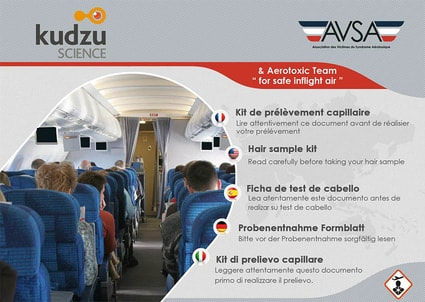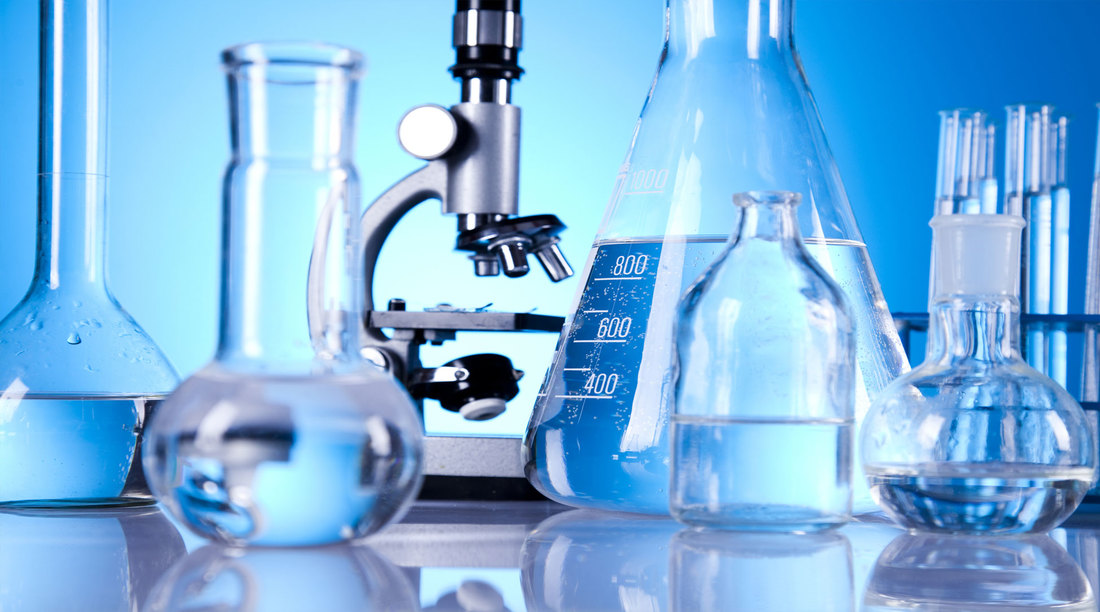International Medical & Laboratory Protocol
3 FREE DOWNLOADS for Medical Staff & Affected Persons
|
Latest updates November 2020

KUDZU Hair Testing for TCP
|
After an incident with suspected cabin air contamination it is in your own best interest to compile a complete medical documentation, including diagnosis in case of subsequent medical problems that may require a work related injury record. If you wish to take legal action, it is imperative to get the tests done within minutes or a couple of hours. Please bear in mind that if you have been poisoned your intellectual functions can be affected, so making decisions can be difficult. Advice: rather get the tests and a diagnosis for your records done - there is always the danger of a later onset of health problems following a poisoning and you need to be able to prove it!
Immediate Action after Exposure First blood and urine samples must be taken within 2 - 3 hours, at the very latest 48 hours. Best tell the medical personnel that the emergency is based on a possible 'poisoning' by inhalation of thermally degraded substances containing CO fumes'. Please also go to THIS WEBSITE for additional valuable information regarding CO+ poisoning (CO+ = carbon monoxide + other toxins) Some of the tests must be done within the 2-3 hours, since those particular values tend to change quickly - they can sink to 50% of the initial value within 4-5 hours - doctors would know this. At the very least get the blood drawn and save several samples of blood and urine. (check details further down). More information can be found in this paper: Physician's Guide to Pesticide Poisoning. The following list shows which values should be analyzed within a 2 hour frame:
Metabolic parameters such as cholesterol and sugar can be omitted. Warning: smoking may impact the measurements, please advise the medical personnel when you had your last cigarette. Have all symptoms such as i.e. change of heart rhythm, shortness of breath and vision problems examined and documented. These fumes can affect all organs, not only the central nervous system! COHb - Carbon monoxide-saturated hemoglobin for forensic purposes. In forensic investigations, there are occasional incidents in which the circumstances seem to point irrefutably to carbon monoxide poisoning, but the blood analysis shows low or normal COHb levels. For the investigation of low-level exposure more sensitive methods involving the release of carbon monoxide and its measurement by gas chromatography are required. For this type of measurement the blood must be sampled on the day of the event, since the half-life is only 245 minutes and therefore the values may be back to normal the following day. It is vital that samples that are not to be dealt with immediately are stored correctly. As little air as possible should be left in the tube and the samples should be placed in a deep freeze without delay, irrespective of the anticipated degree of carboxylation. AChE - (= red blood cell acethylcholinesterase activity) this measurement should not be an issue in a larger clinic/emergency room/university hospital and should also be done on the same day. Preferably previous measurements without/before exposure are available for comparison - but this will most often not be the case. You might get it done anyway, just in case another event happens - then you do have a comparison! More INFO here. How to take and store blood & urine samples Important: Disinfection of the skin area should not be carried out with solvent-containing desinfectants before sample collection, but e.g. with a three-percent aqueous hydrogen peroxide solution. (AMR 6.2); if not available, please note the name of the disinfectant used. Blood: 2 x 5 ml EDTA blood should be taken in clinical chemistry tubes and stored in the deep-freezer (should be minus 20°C/ -4°F) for further (resp. later) toxicological analyses. Urine: Each sample should have about 15ml. Three (3) urine samples on the first day - then over the next five days one (1) sample per day, (on these days use the first urine in the morning after getting up), these are also to be stored in the freezer. Special sterile cups can be optained in pharmacies; if not available, use clean bottles/containers which can be closed airtight. Reminder - Important: Some of the body fluid tests must be done straight after exposure <8within 2-3 hours) as the values deteriorate within 4-5 hours!. At least get the blood drawn and save some samples of blood and urine and store them in the deep-freeze, if possible at minus 20°C (-4 °F). Long Term Effects - an Overview Some, or all symptoms may disappear within hours or days and you will feel fine again. But there is also the possibility of symptoms persisting 'on and off', especially if you are flying as usual. So called 'low level' contamination, meaning: exposure to some constantly present residues in carpets, seats and on the interior walls, and/or unnoticed small leaks can build up a so called 'toxic body burden' and symptoms reappear - often these symptoms will, when you are at home, have a few days off or are on holiday will seem to disappear and you feel better. Symptoms should be continuously documented and medically supervised. A diary with copies of findings should be kept. Presentation: HEALTH EFFECTS AFTER FUME EVENTS Some long-term symptoms can be:
When long-term effects/symptoms persist tests can be made for (within +/-30 days):
When respiratory function tests become necessary due to ongoing respiratory issues:
It is possible to have so called BIO-MONITORING done (samples taken on the same day). The following substances could be present: In the blood:
In the urine:
Whereas the above protocol has been reviewed by medical and other experts who are familiar with the various issues regarding cabin air contamination, this may not be all inclusive. Additional possible tests to check for exposure: Clothing: Worn uniform shirts/blouses (also ties): do not wash, fold well and place it in an airtight packing. Pack samples separately. They can be tested for engine oil, hydraulic oil and glycol residues at various laboratories if necessary. Hair: Tricresyl-Phosphate and certain metabolites can be detected in hair samples. More info here or go direct to: order Blood: Determination of organophosphate exposure and injury to the nervous system by Professor M. Abou-Donia: Auto Antibodies - (view an EXAMPLE report with the results from the blood of a Flight Attendant) available upon request, please contact us here ( Samples for the Auto Antibodies Test must be taken and stored in an even more specific way.) DNA Test - can help determine if you are a poor detoxifier, most laboratories offer this test. It can be helpful for personal knowledge, but at the moment is not a necessity. Some more important INFO'S and Tips The half-life of most VOCs (volatile organic compounds) is typically a few hours; therefore, laboratory results reflect very recent exposures such as within hours or days. If you were exposed a month ago, even every day, you will most likely not see it. Predictive Analysis to be the cockpit of the Toxicology Laboratories Market Laboratory tests for VOCs are technically difficult to perform due to preparation and storage of test tubes. When some chemicals enter the body, they are partially broken down – or 'metabolized' – before they are excreted. Thus, when testing occurs, it is the ‘metabolite’ and not the chemical itself that can be detected, also the levels might be lower than they would have been initially! Various chemicals may have the same metabolite. Consequently, results of the testing may be misleading and must be analyzed well. It is impossible for us to give you names and locations of laboratories and medical practitoners in every country. Not every laboratory can do these tests, as specific technology and training is needed.look for laboratories offering:
specializing in 'analytical laboratory for occupational toxicology and immunology'. Examples to look for in their services:
Some of the toxicology laboratories include Agilent Technologies, Alere Laboratories, Bio-Rad Laboratories, Pacific Toxicology Laboratoies AIT Laboratories, Cardiff Toxicology Services, Aeon clinical laboratories, Quest Diagnostics, Gene Logic, Inc., Molecular Toxicology, Inc., and Covance, Inc". (©source: HERE) Samples sent to a laboratory must be delivered in an uninterrupted frozen condition (e.g. on lots of dry ice in a styrofoam box by courier). Some helpful information to refer to if and when medical doctors wish to have more background:
ORGANOPHOSPATE EXPOSURE and VACCINATIONS read here Don't forget! Documentation of details:
|





